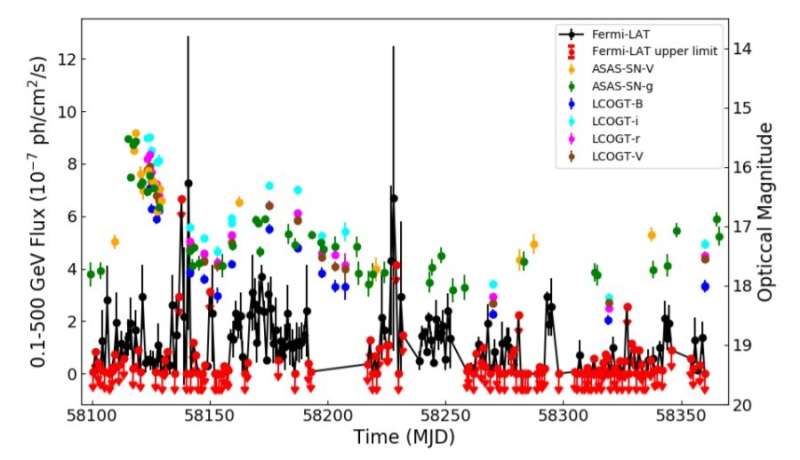March 23, 2021 report
B2 1420+32 is a changing-look blazar, study finds

An international team of astronomers has performed multi-wavelength photometric and spectroscopic observations of a blazar known as B2 1420+32. The observational campaign found that the object exhibits a large scale spectral variability and is the so-called "changing-look" blazar. The findings are reported in a paper published March 15 on arXiv.org.
Blazars, classified as members of a larger group of active galaxies that host active galactic nuclei (AGN), are the most numerous extragalactic gamma-ray sources. Their characteristic features are relativistic jets pointed almost exactly toward the Earth. Based on their optical emission properties, astronomers divide blazars into two classes: flat-spectrum radio quasars (FSRQs) that feature prominent and broad optical emission lines, and BL Lacertae objects (BL Lacs), which do not.
Significant multi-frequency variability on many timescales is one of the characteristic features of AGNs. However, mechanisms behind this variability are still a subject of debate. Among the proposed explanations are changes in the dust extinction, changes in the emission from the accretion disc or its associated comptonization regions, stellar tidal disruption, supernovae in the nuclear regions, and even gravitational microlensing.
AGNs are subdivided into several broad categories, including Type I (also called quasars, Seyfert I) that show a blue continuum from an accretion disk and broad emission lines created by photoionization and Type II (or Seyfert II), which show only narrow lines and no continuum variability. Some AGNs move from one class to another and therefore are dubbed "changing-look" sources. Studying changing look phenomena in blazars can provide useful insight into understanding the origin and particle acceleration processes of radio jets.
Now, a group of astronomers led by Hora D. Mishra of the University of Oklahoma reports the detection of a new changing-look blazar. Using mainly the Las Cumbres Observatory Global Telescope Network (LCOGT), they found that the blazar B2 1420+32, at a redshift of 0.682 and with a black hole mass of about 400 million solar masses, appears to shift back and forth between the optical spectrum of an FSRQ and that of a BL Lac several times, while also developing new spectral features.
"Our multi-wavelength and spectroscopic monitoring observations show that B2 1420+32 exhibits extreme spectral and temporal variability," the researchers wrote in the paper.
The study found that B2 1420+32 showcases large-scale spectral variability in both its continuum and line emission, together with dramatic gamma-ray and optical variability, on week to month timescales.
According to the paper, the gamma-ray and optical fluxes increased by factors of 1500 (8 mags) and 40 (4 mags), respectively, between 2016 and 2019. The astronomers noted that observed optical variability amplitude is unprecedented, as the optical flux increases by a factor of 100 (5 mags) compared to observations conducted in 1995.
All in all, the researchers concluded that B2 1420+32 is a changing-look blazar transiting between FSRQ and BL Lac due to dramatic changes in the jet continuum flux diluting the line features. They emphasized that extreme variability, as in the case of B2 1420+32, has not been observed before in any blazar.
More information: The Changing Look Blazar B2 1420+32, arXiv:2103.08707 [astro-ph.HE] arxiv.org/abs/2103.08707
© 2021 Science X Network





















